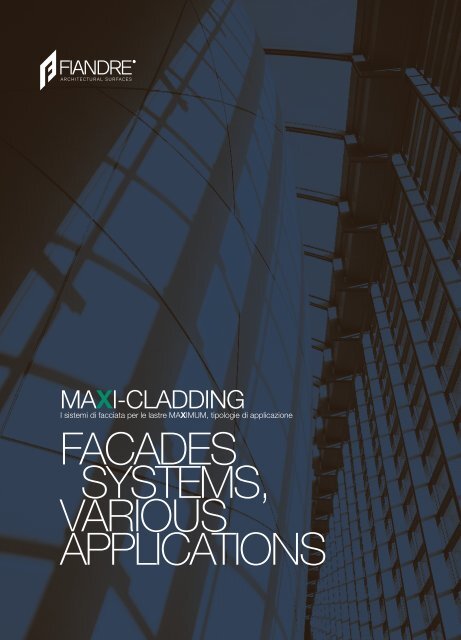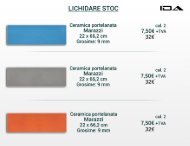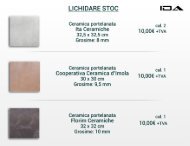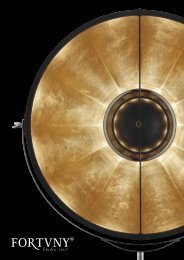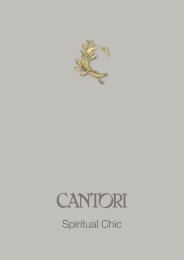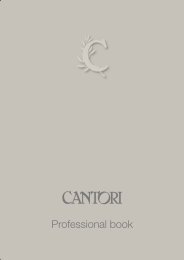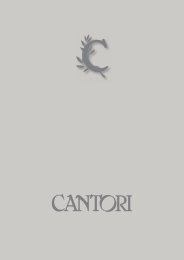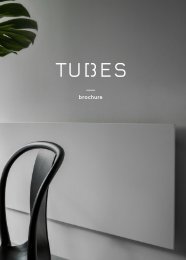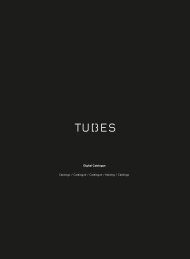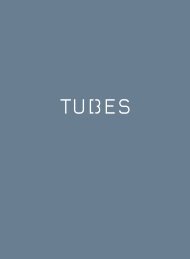Create successful ePaper yourself
Turn your PDF publications into a flip-book with our unique Google optimized e-Paper software.
MAXI-CLADDING<br />
I sistemi di facciata per le lastre MAXIMUM, tipologie di applicazione<br />
FACADES<br />
SYSTEM, SYSTEMS,<br />
VARIOUS<br />
APPLICATIONS<br />
1
04 L’INVOLUCRO EDILIZIO<br />
07 TIPOLOGIE DI APPLICAZIONE LASTRE MAXIMUM A PARETE<br />
10 SISTEMA SAFETY CLIP<br />
14 Utilizzo sistema Safety Clip<br />
15 Rivestimento Safety Clip range dimensionale e utilizzo<br />
14 SISTEMA A CAPPOTTO<br />
20 Sequenza di posa sistema a Cappotto<br />
22 Utilizzo sistema a Cappotto<br />
23 Rivestimento a Cappotto range dimensionale e utilizzo<br />
24 SISTEMA MICRO<br />
29 Sequenza di posa sistema Micro<br />
30 Utilizzo sistema Micro<br />
31 Rivestimento Micro range dimensionale e utilizzo<br />
32 FACCIATA VENTILATA<br />
34 Utilizzo facciata ventilata<br />
36 SISTEMA MAXI FRAME<br />
43 Sequenza di posa sistema Maxi Frame<br />
44 Logistica di cantiere sistema Maxi Frame<br />
45 Rivestimento Maxi Frame range dimensionale e utilizzo<br />
46 SISTEMA MAXI LIGHT<br />
50 Sequenza di posa sistema Maxi Light<br />
52 Logistica di cantiere sistema Maxi Light<br />
53 Rivestimento Maxi Light range dimensionale e utilizzo<br />
54 TAVOLA SINOTTICA:<br />
DOVE E QUANDO UTILIZZARE I SISTEMI<br />
DI RIVESTIMENTO<br />
56 MAXIMUM COLLECTION<br />
58 GLOSSARIO<br />
05 ARCHITECTURAL ENVELOPES<br />
09 TYPES OF WALL APPLICATION FOR MAXIMUM SLABS<br />
10 SAFETY CLIP SYSTEM<br />
14 Safety Clip system use<br />
15 Safety Clip covering size range and use<br />
17 THERMAL CLADDING SYSTEM<br />
20 Cladding System laying sequence<br />
22 Cladding System use<br />
23 Cladding System covering size range and use<br />
25 MICRO SYSTEM<br />
29 Micro system laying sequence<br />
30 Micro system use<br />
31 Micro covering size range and use<br />
32 VENTILATED FAÇADE<br />
35 ventilated façades use<br />
37 MAXI FRAME SYSTEM<br />
43 Maxi Frame system laying sequence<br />
44 Maxi Frame site logistics<br />
45 Maxi Frame covering size range and use<br />
46 SISTEMA MAXI LIGHT<br />
50 Maxi Light system laying sequence<br />
52 Maxi Light site logistics<br />
53 Maxi Light covering size range and use<br />
54 SYNOPTIC TABLE:<br />
EHERE AND WHEN TO USE THE CLADDING SYSTEM<br />
56 MAXIMUM COLLECTION<br />
59 GLOSSARY<br />
© 2013 - 2014 <strong>Graniti</strong><strong>Fiandre</strong> S.p.A - Tutti i diritti riservati.<br />
E’ vietata la riproduzione, anche parziale, di immagini, testi o contenuti.<br />
© 2013 - 2014 <strong>Graniti</strong><strong>Fiandre</strong> S.p.A - All rights reserved.<br />
Reproduction in whole or in part of the images, texts or contents is prohibited.<br />
2<br />
3
ARIA FREDDA<br />
Cold air<br />
Termografia di edificio ben isolato e senza ponti termici.<br />
Thermography of a well-insulated building with no thermal bridges.<br />
Termografia di edificio non isolato e con evidenza di ponti termici tra involucro opaco e serramenti.<br />
Thermography of an uninsulated building, highlighting the thermal bridges between the opaque<br />
envelope and the windows.<br />
ARCHITECTURAL ENVELOPES<br />
Envelope refers to building elements which both connect and separate the “inside” and “outside” of a residential building. It establishes a relationship<br />
between the building and its environment, an authentic architectural and construction filter, in turn creating relations between the people who live in a<br />
building and the surrounding environment.<br />
Architectural envelopes have always represented a privileged yet highly complex field of innovation. The continuous research into special, advanced<br />
forms and technologies, the increasingly pressing need for customisation and the fact of acting as the building’s calling card in its environmental and<br />
social context, have always made this an extraordinarily important part of a building, and with it the materials and construction systems used to create it.<br />
ARIA CALDA<br />
Hot air<br />
The current function of building envelopes as filters also supports the dynamic control of energy exchanges that constantly take place between the<br />
inside and outside, making the envelope a dynamic interface that interacts continuously with the external environmental and climatic factors, an authentic<br />
skin, which together with its construction systems is responsible for optimising the internal comfort of the building and maximising its performance<br />
requirements. In this scenario, therefore, the efficiency of a building envelope lies in its ability to react flexibly to the continuously varying environmental<br />
conditions, minimising heat dispersion in winter and excessive heat gain in summer.<br />
Currently this aspect is of particular relevance, given the growing focus on energy saving and residential comfort, issues which are increasingly attracting<br />
the attention of architects and designers, investors and builders, as well as customers and end users. The technological and architectural solutions<br />
demanded today by the market therefore strive not only for architectural quality, but also energy efficiency, with the possibility to blend quality and<br />
functionality in a single building envelope that controls both the energy behaviour of the building and its appearance.<br />
A building envelope, as a construction element, is composed of vertical elements (walls and windows) and horizontal elements (floors and roofs): the<br />
set of these components creates the perimeter of the living space. In this technical catalogue, we deal in particular with façade covering systems used<br />
to create building envelopes using Maximum slabs.<br />
L’INVOLUCRO ARCHITETTONICO<br />
L’involucro è l’elemento della costruzione che delimita lo spazio abitato, separa il «dentro» dal «fuori» e media, connette e separa l’interno e l’esterno.<br />
Esso determina quindi il rapporto tra edificio e ambiente, come un vero e proprio filtro architettonico e costruttivo, regolando di conseguenza anche i<br />
rapporti tra le persone che vivono l’edificio e l’ambiente circostante.<br />
ANALISI TERMICA<br />
Thermal Analysis<br />
L’involucro architettonico rappresenta da sempre un luogo privilegiato per l’innovazione, sebbene sia ricco di complessità. La continua ricerca di forme<br />
e tecnologie particolari e avanzate, la necessità sempre più spinta di personalizzazione e il suo essere il biglietto da visita dell’edificio nei confronti del<br />
contesto ambientale e sociale, rende questa parte della costruzione di straordinaria importanza e rilevanza, e con essa i materiali e i sistemi costruttivi<br />
con cui è realizzata.<br />
L’attuale funzione di filtro dell’involucro edilizio è anche relativa al controllo dinamico degli scambi energetici che avvengono costantemente tra interno<br />
ed esterno, rendendo quindi l’involucro una interfaccia dinamica in continua interazione con i fattori climatici e ambientali esterni come una vera e<br />
propria pelle, demandando ad esso e ai sistemi con cui è costruito, l’ottimizzazione del comfort interno degli spazi e la massimizzazione dei requisiti<br />
prestazionali dell’edificio. L’efficienza di un involucro edilizio in questo scenario, pertanto, può essere ritrovata nella sua capacità di reagire in modo<br />
flessibile alle condizioni ambientali in continua variazione, minimizzando le dispersioni termiche in inverno e l’eccessivo guadagno di calore in estate.<br />
Attualmente tale aspetto assume una rilevanza particolare, vista l’attenzione crescente verso il contenimento energetico e il comfort degli spazi, temi<br />
che sempre più interessano architetti e progettisti, investitori e costruttori, ma anche clienti e utenti finali. Le soluzioni tecnologiche ed architettoniche<br />
che il mercato oggi richiede sono, dunque, finalizzate non solo a realizzare una architettura di qualità, ma anche energeticamente efficiente, grazie alla<br />
possibilità di sposare qualità e funzionalità in un involucro edilizio che influenzi il comportamento energetico dell’edificio, oltre al suo aspetto estetico.<br />
Si può dire che l’involucro edilizio in quanto elemento della costruzione sia composto da elementi verticali (le pareti e i serramenti) e orizzontali (pavimenti<br />
e coperture): l’insieme di tali componenti perimetra lo spazio abitato. In questo catalogo tecnico ci si occuperà in particolare dei sistemi di rivestimento<br />
di facciata per l’involucro edilizio con lastre Maximum.<br />
RETICOLO AD ELEMENTI<br />
FINITI<br />
Finite element Mesh<br />
DIREZIONE DEL FLUSSO<br />
TERMICO<br />
Thermal flux vectors<br />
DISTRIBUZIONE DELLE<br />
TEMPERATURE<br />
Temperature distribution<br />
INTENSITA’ DEL FLUSSO TERMICO<br />
Thermal flux magnitude<br />
4<br />
5
TIPOLOGIE DI APPLICAZIONE LASTRE MAXIMUM A PARETE<br />
Per l’applicazione delle lastre Maxi a parete sono disponibili una serie di sistemi di applicazione che possono essere suddivisi in due famiglie:<br />
INVOLUCRO A UMIDO:<br />
a. Sistema Safety Clip<br />
Posa tradizionale a colla con gancio a scomparsa.<br />
La posa a parete di lastre Maximum direttamente sulla<br />
muratura esistente con sistemi a colla prevede la stesura, sul<br />
100% del fondo di posa, di idoneo collante scelto in base a:<br />
- Fondo di posa, supporto su cui applicare la lastra con<br />
adeguate caratteristiche di resistenza<br />
- Caratteristiche di adesione e strappo<br />
- Formato del materiale<br />
- Composizione della facciata<br />
- Condizioni climatiche e ambientali<br />
b. Sistema a Cappotto<br />
La posa di lastre Maximum su un sistema di isolamento a<br />
cappotto, ai fini dell’ottenimento di un adeguato comfort<br />
termico degli edifici, avviene mediante realizzazione in<br />
opera di uno specifico sistema che necessita di un supporto<br />
meccanicamente resistente, composto da strati giustapposti<br />
alla muratura:<br />
- Intonaco<br />
- Isolante<br />
- Intonaco armato<br />
- Lastra in gres porcellanato<br />
INVOLUCRO A SECCO:<br />
c. Sistema Micro<br />
Il sistema Micro è un sistema di incollaggio per il<br />
montaggio di lastre in gres porcellanato in facciata.<br />
Esso è composto da un adesivo permanente ad alta elasticità<br />
e da un nastro di montaggio biadesivo, previo trattamento<br />
preliminare del sottofondo, che insieme fissano la lastra in<br />
facciata in maniera invisibile.<br />
Il sistema prevede l’impiego di una sottostruttura metallica<br />
che, addossata alla parete da rivestire o eventualmente sopra<br />
l’isolante posto a cappotto, determina una retroventilazione<br />
dei pannelli.<br />
d. Facciata Ventilata<br />
La facciata ventilata è un sistema che permette il<br />
rivestimento di un edificio mediante assemblaggio tra<br />
l’elemento di rivestimento (lastre Maximum) e elementi<br />
portanti in alluminio, mediante giunti strutturali eseguiti in<br />
stabilimento.<br />
Sono state messe a punto due sottofamiglie di sistemi,<br />
con in comune l’assemblaggio struttura/lastra tramite giunto<br />
strutturale, diverse nella tipologia di struttura che consente<br />
di ancorare Maximum alla parete dell’edificio:<br />
- Maxi Frame: che utilizza un telaio perimetrale autoportante<br />
che viene appeso a staffe modulari ancorate alla parete.<br />
- Maxi Light: che usa profili di raccordo verticali sagomati per<br />
essere fissati a un tradizionale reticolo di montanti e traversi<br />
prefissato alla parete.<br />
6<br />
7
TYPES OF WALL APPLICATION FOR MAXIMUM SLABS<br />
A series of application systems are available for assembling Maxi slabs on walls. These can be divided into two families:<br />
WET ENVELOPES:<br />
a. Safety Clip system<br />
Dry application of Maximum slabs directly onto the existing<br />
wall by gluing, a layer of suitable glue is spread over 100%<br />
of the laying surface, chosen according to:<br />
- Laying base, support on which the slab is applied, with<br />
suitably resistant features.<br />
- Adhesion and tearing strength<br />
- Material size<br />
- Façade composition<br />
- Climatic and environmental conditions<br />
b. Thermal cladding system<br />
Maximum slabs are laid on a thermal cladding system to<br />
ensure appropriate thermal comfort inside the building,<br />
through the application of a specific system requiring a<br />
mechanically resistant support made of a series of layers<br />
applied to the brickwork:<br />
- Plaster<br />
- Insulating layer<br />
- Reinforced plaster<br />
- Porcelain stoneware slab<br />
DRY ENVELOPES:<br />
c. Micro system<br />
The Micro system uses an adhesive to apply the porcelain<br />
stoneware slabs to the building façade. It comprises a<br />
permanent, highly elastic adhesive and a double-sided<br />
adhesive assembly tape; the base support is firstly treated<br />
and then the slab is fixed to the façade with this invisible<br />
system. The system includes a metal under-frame fitted to<br />
the wall or on top of the thermal cladding, which ensures the<br />
ventilation behind the panels.<br />
d. Ventilated façade<br />
The ventilated façade system involves the assembly of the<br />
covering elements (Maximum slabs) onto aluminium<br />
load-bearing elements using factory-mounted structural<br />
joints.<br />
Two sub-families of this system have been developed.<br />
While they share the frame-slab assembly using structural<br />
joints, they have different types of structures to anchor the<br />
Maximum slabs to the wall:<br />
- Maxi Frame: which uses a load-bearing perimeter frame<br />
hung on modular brackets anchored to the wall.<br />
- Maxi Light: a system of vertical shaped profiles fixed to a<br />
traditional grid of uprights and cross-beams fixed to the wall.<br />
8<br />
9
SISTEMA SAFETY CLIP<br />
Posa tradizionale a colla con gancio a scomparsa<br />
SAFETY CLIP SYSTEM<br />
Conventional glue-mounting system with concealed hooks<br />
SISTEMA BREVETTATO / INVOLUCRO A UMIDO<br />
PATENTED SYSTEM / WET ENVELOPES<br />
La posa a colla di lastre in gres porcellanato sottile e di grandi dimensioni avviene mediante stesura, sul fondo di posa, di un collante appositamente scelto in<br />
base al fondo stesso di posa, al formato del materiale, alla composizione della facciata e alle condizioni climatiche e ambientali.<br />
L’applicazione della colla, che avviene mediante spatola dentata in uno spessore che va da 5 a 10 mm, necessita di una superficie planare e senza onde, a<br />
causa della limitata capacità dell’adesivo di compensare eventuali irregolarità di sottofondo. In funzione del singolo progetto da realizzare, saranno previsti, in<br />
fase di progettazione, idonei giunti strutturali e di frazionamento.<br />
Per aumentare la sicurezza del sistema e per applicazioni su altezze superiori a 2,4 metri, si predispone un gancio di sicurezza in acciaio inox, montato sul retro<br />
della lastra (previa incisione meccanica della stessa) e a filo con la sua superficie, meccanicamente agganciato alla muratura.<br />
Tutte le lavorazioni sulla lastra, per garantire la massima qualità e tenuta, sono eseguite esclusivamente in fabbrica.<br />
A glue, chosen specifically to suit the laying surface, the material size, the façade composition and the climatic and environmental conditions, is spread on the<br />
laying surface to support the large-sized, thin porcelains stoneware slabs.<br />
The glue, applied using a toothed spatula with a thickness of 5 to 10 mm, requires a flat, smooth surface, as it has a limited capacity to compensate any unevenness<br />
in the underlying surface. Depending on the specific project, suitable structural joints and expansion joints are included in the design.<br />
To increase the safety of the system and for applications on heights above 2.4 metres, a stainless steel safety hook is fitted to the back of the slab (using a<br />
mechanical incision), which is in turn hooked mechanically onto the building, flush to the wall.<br />
To ensure maximum quality and resistance, the slab processing is performed exclusively at the factory.<br />
1. SAFETY CLIP<br />
(gancio sicurezza a scomparsa)<br />
(Concealed safety hook)<br />
2. LASTRA MAXIMUM<br />
Maximum Slabs<br />
3. COLLANTE<br />
Glue<br />
4. MURATURA PORTANTE ED INTONACO<br />
Load-bearing wall and laster<br />
2<br />
2<br />
3<br />
4<br />
1<br />
1<br />
3<br />
4<br />
300 cm<br />
dettaglio verticale - vertical detail<br />
dettaglio orizzontale - horizontal detail<br />
10<br />
11
EVENTS GALLERY – BALOCCO CIRCUIT, ITALY<br />
12<br />
13
UTILIZZO SAFETY CLIP<br />
Safety Clip use<br />
RIVESTIMENTO SAFETY CLIP RANGE DIMENSIONALE E UTILIZZO<br />
Safety clip covering size range and use<br />
PATENTED SYSTEM<br />
PATENTED SYSTEM<br />
750 1000 1200 1500 1800 2250 3000<br />
1800<br />
2250<br />
1500<br />
1200<br />
1000<br />
750<br />
h. 3 MT<br />
h. 6 MT<br />
3000<br />
h. 20 MT<br />
La tecnologia dell’incollaggio tradizionale può essere applicato per qualsiasi dimensione di lastra, ma per applicazioni oltre i 2,4 metri si consiglia<br />
l’utilizzo del ritegno di sicurezza.<br />
L’applicazione delle lastre in gres porcellanato direttamente sul supporto murario rende il sistema adatto per involucri esterni in cui non è necessaria o<br />
richiesta alcuna performance energetica dell’involucro, oppure laddove il supporto murario sia già adeguatamente isolato.<br />
Nello schema sottostante si propone un range dimensionale e alcune indicazioni principali sull’incollaggio di lastre Maximum in rivestimento esterno in<br />
funzione del posizionamento delle stesse in facciata.<br />
Conventional gluing technologies can be used with any size of slab, but for applications above 2.4 metres it is advisable to use safety retainers.<br />
The application of the porcelain stoneware slabs directly onto the brickwork makes the system suited for envelopes that do not require high-energy<br />
performance, or where the walls are already suitably insulated.<br />
The diagram below describes the size ranges and some key indications for gluing Maximum slabs on outer walls depending on their position on the<br />
façade.<br />
NOTE: Si ricorda che il range dimensionale è puramente indicativo, poiché è possibile realizzare rivestimenti in esterno con lastre di tutte le dimensioni, fino al formato pieno<br />
(300x150 cm). - The size range is purely indicative, as external coverings can be produced using slabs of all sizes (up to 300x150 cm).<br />
La legenda si riferisce all’altezza fuoriterra dell’edificio - The key refers to the height above ground of the building<br />
14<br />
15
SISTEMA A CAPPOTTO<br />
THERMAL CLADDING SYSTEM<br />
INVOLUCRO A UMIDO WET ENVELOPES<br />
Il sistema di rivestimento a cappotto ha raggiunto negli ultimi anni una notevole diffusione in Europa grazie alle crescenti e cogenti necessità di garantire un<br />
adeguato comfort termico degli edifici, sia di nuova costruzione che in ristrutturazione. L’isolamento dell’involucro edilizio è, infatti, il primo passo per il contenimento<br />
dei flussi energetici e la riduzione del fabbisogno energetico negli edifici, e si traduce in un miglior comfort per gli utenti e un risparmio economico<br />
dettato dal minor consumo di energia necessaria per riscaldare e raffrescare gli ambienti.<br />
Il sistema per realizzare un cappotto termico con lastre Maximum mutua la stratigrafia del tradizionale sistema a cappotto con finitura minerale, ma rispetto ad<br />
essa conferisce un valore aggiunto determinato dalla finitura in lastre di gres porcellanato sottile.<br />
Il sistema a cappotto permette infatti la posa, sullo strato di isolamento termico (il cui spessore deve essere deciso sulla base dei calcoli di progetto) di lastre<br />
in gres porcellanato dello spessore di 6 mm.<br />
Il sistema proposto richiede un supporto meccanicamente resistente, per ottenere il quale è stato studiato un sistema di rivestimento e posa su pannelli isolanti<br />
in EPS o XPS (rispettivamente polistirene espanso o polistirene espanso estruso) caratterizzato da elevate resistenze meccaniche (a trazione e compressione)<br />
e basso modulo elastico, in grado di sostenere il peso e le sollecitazioni generate dai rivestimenti e dalle dilatazioni termiche.<br />
L’isolante deve avere una superficie ruvida per favorire l’aggrappaggio del rivestimento e profili squadrati e privi di battente, e spessore ricavato dal calcolo di<br />
progetto. Per quanto riguarda le lastre di rivestimento sono da prediligere colori chiari, che abbiano un indice di riflessione superiore al 20%.<br />
Ciò premesso, occorre sottolineare come il raggiungimento dei risultati attesi in termini di isolamento termico e di durabilità del rivestimento è strettamente correlato<br />
alla accurata e corretta progettazione dei particolari costruttivi del sistema in tutti i punti in cui si potrebbe venire a creare un ponte termico e alla corretta<br />
realizzazione delle opere.<br />
In the past few years, thermal cladding has become increasingly widespread in Europe due to the growing statutory and technical requirements to ensure heat<br />
comfort in both new builds and renovations. The insulation of any building envelope is the first step to ensuring the reduction in energy flows and consumption<br />
in any building, and translates into improved comfort for users and financial savings due to lower energy consumption to heat and cool the inside.<br />
The thermal cladding system using Maximum slabs changes the outer layer of conventional cladding systems which have mineral finishes, but adds greater<br />
value with the finishing layer in thin porcelain stoneware slabs.<br />
The thermal cladding system involves the laying of a 6 mm thick porcelain stoneware slab on top of a heat insulating layer (the thickness of which is decided<br />
according to design calculations).<br />
The proposed system requires a mechanically resistant support, designed using a covering and laying system on EPS or XPS (respectively, expanded polystyrene<br />
or extruded polystyrene) insulating panels with high mechanical resistance (to traction and compression) and low elastic modulus, able to support the<br />
weight and stress generated by the coverings and by thermal expansion.<br />
The insulating layer must have a rough surface in order to allow the covering to grip, with square profiles and no ledges, of a thickness established in the design<br />
calculations. For covering slabs, pale colours with a reflective index of greater than 20% should be chosen.<br />
Having said this, it should be underlined that the achievement of expected results in terms of heat insulation and durability of the outer covers is closely related<br />
to the careful and correct design of the construction details of the system, in all points which could create a thermal bridge, as well as the correct installation<br />
of the system.<br />
2<br />
2<br />
dettaglio verticale - vertical detail<br />
2<br />
6<br />
5<br />
4<br />
3<br />
1<br />
1. LASTRA MAXIMUM<br />
Maximum slab<br />
2. COLLANTE<br />
Glue<br />
3,4,5<br />
6<br />
7<br />
3. INTONACO ARMATO<br />
4. Reinforced plaster<br />
5.<br />
8<br />
6. ISOLANTE<br />
Insulating layer<br />
7<br />
7. INTONACO E COLLANTE<br />
Plaster and glue<br />
8<br />
8. MURATURA PORTANTE<br />
Load-bearing wall<br />
16<br />
17
PRIVATE HOUSING - PESARO, ITALY<br />
18<br />
19
SEQUENZA DI POSA SISTEMA A CAPPOTTO<br />
Cladding System laying sequence<br />
INVOLUCRO A UMIDO / WET ENVELOPES<br />
AL FINE DI UNA CORRETTA REALIZZAZIONE DEL SISTEMA A CAPPOTTO, OCCORRE SEGUIRE ALCUNI ACCORGIMENTI:<br />
1. La posa dovrà essere eseguita con il metodo della doppia spalmatura, stendendo l’adesivo sia sul sottofondo che sul retro della lastra, per garantire<br />
l’assenza di vuoti all’interfaccia rivestimento/supporto, dove l’acqua piovana, infiltrandosi, potrebbe ristagnare creando (in caso di gelo) tensioni che<br />
potrebbero provocare il distacco del rivestimento. Inoltre, in questo modo si ripartiscono in modo uniforme e su una superficie più ampia le tensioni<br />
che si avranno a seguito dei movimenti differenziali tra rivestimento e supporto, dovuti ad esempio a variazioni termiche, e per evitare fenomeni di<br />
efflorescenze in facciata.<br />
2. La posa deve essere effettuata a fuga larga, con larghezza correlata al formato delle lastre e alle condizioni climatiche locali.<br />
3. Occorre rispettare i giunti strutturali, sia per quanto riguarda dimensione che posizione. Si dovranno inoltre prevedere giunti di frazionamento in<br />
corrispondenza di fasce marcapiano, angoli e spigoli (e in ogni caso ogni 9-12 mq)<br />
4. Occorre proteggere il rivestimento dalla penetrazione di acqua e potenziali danni da cicli di gelo-disgelo mediante applicazione di adeguate sigillature<br />
o scossaline metalliche nella parte superiore e inferiore dell’intero rivestimento, e in corrispondenza di finestre e aperture.<br />
THE FOLLOWING RECOMMENDATIONS HELP TO ENSURE THE CORRECT INSTALLATION OF THE CLADDING SYSTEM:<br />
1. The system should be laid using the double glue spreading method, spreading the glue on both the underlying surface and the back of the slab, to<br />
prevent voids between the covering and the support, where rainwater could filter in and (in the event of frost) create stress which could cause the<br />
slab to become detached. Moreover, this method ensures that the stress caused by the differential movements between the slabs and the support<br />
surface, due for example to variations in temperature, is spread more evenly, thus preventing efflorescence on the façade.<br />
2. The slabs must be laid with wide gaps to suit the slab size and the local climatic conditions.<br />
3. Structural joints must be fitted to suit both slab size and position. Expansion joints must also be inserted along string courses, corners and ridges<br />
(and in any case every 9-12 m2)<br />
4. The covering must be protected against water infiltration and potential damage from freezing-melting by fitting suitable seals or metal flashing on the<br />
top and bottom of the whole covering, as well as around doors and windows.<br />
20<br />
21
UTILIZZO SISTEMA CAPPOTTO<br />
Thermal Cladding System use<br />
RIVESTIMENTO A CAPPOTTO RANGE DIMENSIONALE E UTILIZZO<br />
Covering with Thermal Cladding size range and use<br />
INVOLUCRO A UMIDO / WET ENVELOPES<br />
INVOLUCRO A UMIDO / WET ENVELOPES<br />
750 1000 1200 1500 1800 2250 3000<br />
1800<br />
1500<br />
1200<br />
1000<br />
750<br />
2250<br />
375<br />
IL SISTEMA COMPRENDE:<br />
THE SYSTEM INCLUDES:<br />
Isolamente a cappotto tipo XPS o EPS<br />
Thermal cladding, type XPS or EPS<br />
Il Sistema a Cappotto viene utilizzato in tutti gli interventi di nuova costruzione o ristrutturazione in cui si ha necessità di isolare termicamente<br />
l’involucro edilizio e di raggiungere i necessari valori di legge di trasmittanza dei componenti verticali di involucro o di fabbisogno energetico di<br />
energia per il funzionamento dell’edificio.<br />
Si sottolinea il fatto che, in caso di nuova costruzione o di ristrutturazione ingente di un immobile, sussiste l’obbligo di rispettare i requisiti prestazionali<br />
sopra indicati e che sono attualmente in vigore alcune misure incentivanti l’efficientamento energetico degli edifici mediante detrazioni fiscali (in cui<br />
può rientrare il sistema a cappotto).<br />
Nello schema sottostante si propone un range dimensionale e alcune indicazioni principali sull’incollaggio di lastre Maximum in rivestimento a<br />
cappotto esterno.<br />
Si ricorda che il range dimensionale è puramente indicativo, poiché è possibile realizzare rivestimenti in esterno con lastre Maximum di tutte le<br />
dimensioni, fino al formato 150x150 cm.<br />
3000<br />
Pacchetto finitura cappotto<br />
Cladding finishing system<br />
h. 20 MT<br />
The Cladding System is used in all new builds and renovations where the building envelope has to be insulated, and to meet statutory requirements<br />
concerning the transmittance of vertical components and energy needs linked to the building.<br />
It should be underlined that in the case of new builds or large-scale renovations, the above-indicated performance requirements are obligatory and<br />
that incentives in the form of tax deductions may be available for energy efficiency measures (including thermal cladding systems).<br />
The diagram below describes the size ranges and some key indications for gluing Maximum slabs on outer walls with thermal cladding.<br />
The size range is purely indicative, as external coverings can be produced using Maximum slabs of all sizes (up to 150x150 cm).<br />
NOTE: Si ricorda che il range dimensionale è puramente indicativo, poiché è possibile realizzare rivestimenti in esterno con lastre di tutte le dimensioni, fino al formato pieno<br />
(150x150 cm). - The size range is purely indicative, as external coverings can be produced using slabs of all sizes (up to 150x150 cm).<br />
La legenda si riferisce all’altezza fuoriterra dell’edificio - The key refers to the height above ground of the building.<br />
XPS: Polistirene estruso - Extruded polystyrene<br />
EPS: Polistirene ESPANSO SINTERIZZATO - Sintered expanded polystyrene<br />
22<br />
23
SISTEMA MICRO<br />
Sistema di incollaggio per rivestimento retroventilato<br />
MICRO SYSTEM<br />
Adhesive system for rear-ventilated coverings<br />
INVOLUCRO A SECCO<br />
DRY ENVELOPES<br />
Il sistema Micro permette il montaggio di lastre in gres porcellanato sottile e di grandi dimensioni come rivestimento retroventilato; il sistema si configura come<br />
una facciata ventilata e ne sfrutta i vantaggi, grazie alla presenza di una intercapedine determinata dalla sottostruttura metallica che distacca il rivestimento in<br />
lastre di gres dal paramento murario.<br />
Rispetto alle facciate ventilate ad ancoraggio meccanico, tuttavia, questo sistema presenta un sistema di fissaggio delle lastre di rivestimento sulla sottostruttura<br />
metallica di tipo chimico-adesivo. L’assemblaggio delle lastre avviene infatti in cantiere mediante impiego di un nastro di montaggio biadesivo e di un<br />
adesivo permanente a base poliuretanica ad alta elasticità, insieme, fissano il rivestimento in maniera invisibile.<br />
Il sistema è composto da un rivestimento esterno in lastre Maximum, una intercapedine ventilata all’interno della quale è possibile prevedere l’inserimento di<br />
un materiale isolante e/o fonoassorbente (per incrementare l’efficienza energetica della facciata), una sottostruttura metallica realizzata in profili in alluminio<br />
di forma a omega ancorati meccanicamente alla muratura retrostante, che supporta i carichi trasmessi dalla sottostruttura e dalle forze agenti sui pannelli di<br />
rivestimento.<br />
The Micro system involves the assembly of thin porcelain stoneware slabs onto a rear-ventilated covering; it belongs to the family of ventilated façades due to<br />
the cavity wall which is created using a metal sub-frame that keeps the porcelain stoneware covering at a distance from the wall facing.<br />
Compared to ventilated façades with mechanical anchoring, however, this system uses a chemical-adhesive metal sub-frame to fix the slabs. The slabs are<br />
assembled using a highly elastic permanent adhesive and a double-sided adhesive assembly tape which, together, fix the covering invisibly to the wall.<br />
The Micro System is composed of an external cladding made by Maximum slabs, a ventilated cavity, within which a thermal and/or acoustic insulation layer<br />
can be placed (in order to improve the facade energy efficiency), a metallic substructure, made by aluminum omega profiles mechanically anchored to the wall,<br />
which supports the loads transmitted by the substructure and the forces acting on the cladding panels.<br />
Given the flexibility and special features of this system, it has to be designed specifically on a case-by-case basis.<br />
Data la peculiarità del sistema e la sua flessibilità, esso richiede una pianificazione fatta ad hoc per ogni progetto.<br />
2. LASTRA MAXIMUM<br />
Maximum slab<br />
2. STRUTTURA IN ALLUMINIO<br />
Aluminium frame<br />
3. NASTRO BIADESIVO + ADESIVO<br />
STRUTTURALE<br />
Double sided fixing tape + structural<br />
adhesive<br />
4. ISOLANTE<br />
Insulating layer<br />
5. INTONACO E COLLANTE<br />
6. Plaster and glue<br />
7. MURATURA PORTANTE<br />
Load-bearing wall<br />
2<br />
1<br />
4<br />
3<br />
150 cm<br />
5<br />
6<br />
150 cm<br />
dettaglio orizzontale - horizontal detail<br />
24<br />
25
LAMBORGHINI HEADQUARTERS - SANT’AGATA BOLOGNESE - BOLOGNA, ITALY<br />
26<br />
27
SEQUENZA DI POSA SISTEMA MICRO<br />
Micro System laying sequence<br />
INVOLUCRO A SECCO - DRY ENVELOPES<br />
Nella posa in opera del sistema, realizzato in cantiere, è necessario rispettare un’apposita procedura di installazione messa a punto e il rispetto di<br />
condizioni climatiche e di cantiere per la corretta installazione, che dovrà avvenire attraverso squadre di posa dotate di opportuna formazione tecnica.<br />
La procedura di installazione verrà fornita insieme al materiale necessario per la posa. Si consiglia di tenere un verbale di incollaggio e di dotarsi di<br />
idonea strumentazione per la registrazione delle condizioni climatiche e di cantiere.<br />
When laying this system, developed directly on site, the special installation procedure must be followed, complying with the climatic conditions and<br />
work site conditions for correct installation, which must be done by suitably trained laying teams. The installation procedure is provided with the laying<br />
materials. It is advisable to keep a gluing record and use appropriate instruments to record the climatic and work site conditions.<br />
28<br />
29
UTILIZZO SISTEMA MICRO<br />
Micro System use<br />
RIVESTIMENTO MICRO RANGE DIMENSIONALE E UTILIZZO<br />
Micro covering system size range and use<br />
INVOLUCRO A SECCO - DRY ENVELOPES<br />
INVOLUCRO A SECCO - DRY ENVELOPES<br />
750 1000 1200 1500 1800 2250 3000<br />
1500<br />
1200<br />
1000<br />
750<br />
IL SISTEMA COMPRENDE - THE SYSTEM INCLUDES<br />
1800<br />
- Isolamente a cappotto tipo XPS o EPS<br />
Thermal cladding, type XPS or EPS<br />
- Retinatura sul retro lastra Maximum<br />
Meshing on the rear of the Maximum slab<br />
Il sistema Micro può essere utilizzato in tutti gli interventi di nuova costruzione o ristrutturazione, fino a un massimo di 20 metri circa di altezza.<br />
La possibilità di inserire nel pacchetto di facciata uno strato di isolante rende il sistema performante anche dal punto di vista energetico, utilizzabile<br />
quindi in interventi in cui si ha necessità di isolare termicamente l’involucro edilizio e di raggiungere determinati valori di trasmittanza dei componenti<br />
verticali di involucro o di fabbisogno energetico di energia per il funzionamento dell’edificio.<br />
2250<br />
- Sottostruttura<br />
Sub-frame<br />
- Fissaggio specifico sulla base del tipo di muratura e di isolante previsto<br />
Specific fixing according to the size and type of insulation<br />
- Collante sistema Micro<br />
Micro system glue<br />
Si sottolinea il fatto che, in caso di nuova costruzione o di ristrutturazione ingente di un immobile, sussiste l’obbligatorietà di rispettare i requisiti prestazionali<br />
sopra indicati e che sono attualmente in vigore alcune misure incentivanti all’efficientamento energetico degli edifici mediante detrazioni fiscali.<br />
h. 6 MT<br />
Nello schema sottostante si propone un range dimensionale e alcune indicazioni principali sull’incollaggio di lastre Maximum in rivestimento esterno<br />
in funzione del posizionamento delle stesse in facciata. Si ricorda che il range dimensionale è puramente indicativo, poiché è possibile realizzare<br />
rivestimenti in esterno con lastre di tutte le dimensioni, fino al formato pieno (300x150 cm).<br />
3000<br />
h. 20 MT<br />
The Micro system can be used in any new build or renovation, up to a maximum height of 20 metres.<br />
The possibility to include an insulating layer in the façade increases the energy performance of the system, so it can also be used in projects that<br />
require the heat insulation of the building envelope in order to achieve certain transmittance values of the vertical envelope components and meet the<br />
building’s energy requirements.<br />
It should be underlined that in the case of new builds or large-scale renovations, the above-indicated performance requirements are obligatory and that<br />
incentives in the form of tax deductions may be available for energy efficiency measures.<br />
The diagram below describes the size ranges and some key indications for gluing Maximum slabs on outer walls depending on their position on the<br />
façade. The size range is purely indicative, as external coverings can be produced using slabs of all sizes (up to 300x150 cm).<br />
NOTE: Si ricorda che il range dimensionale è puramente indicativo, poiché è possibile realizzare rivestimenti in esterno con lastre di tutte le dimensioni, fino al formato pieno<br />
(300x150 cm). - The size range is purely indicative, as external coverings can be produced using slabs of all sizes (up to 300x150 cm).<br />
La legenda si riferisce all’altezza fuoriterra dell’edificio - The key refers to the height above ground of the building.<br />
XPS: Polistirene estruso - Extruded polystyrene<br />
EPS: Polistirene espanso sinterizzato - Sintered expanded polystyrene<br />
30<br />
31
FACCIATA VENTILATA<br />
Ventilated façade<br />
FACCIATA VENTILATA<br />
Ventilated façade<br />
INVOLUCRO A SECCO - DRY ENVELOPES<br />
MAXI FRAME SYSTEM<br />
MAXI LIGHT SYSTEM<br />
Grazie ai sistemi di facciata ventilata, Maximum rimane “Maxi” anche per questi sistemi tecnologici di involucro: è possibile infatti rivestire qualsiasi edificio, sia<br />
esso modulare e che fa della ripetitività dei moduli la propria peculiarità (caratteristica vincente per l’utilizzo di formati “pieni” quali il 300x150-120-100 cm), che<br />
non modulare e quindi richiedente elementi multipli, ma differenziati in dimensione e forme.<br />
L’applicazione delle lastre in facciata ventilata utilizza la tecnologia dell’assemblaggio tra elemento di rivestimento ed elementi portanti in alluminio mediante<br />
giunti strutturali realizzati in stabilimento, seguendo una rigorosa e meticolosa procedura.<br />
Lo studio pre-progetto, l’adeguamento degli standard del sistema al singolo edificio, unitamente al controllo sistematico dei materiali e delle superfici di<br />
aggrappaggio del giunto strutturale, consentono infatti di sfruttare appieno le proprietà complementari di Maximum e della struttura in alluminio, ma soprattutto<br />
di eliminare dal cantiere qualsiasi operazione che non sia un semplice ancoraggio meccanico: Maximum per i sistemi di rivestimento, si presenta quindi<br />
preparata ad essere “semplicemente” agganciata e serrata in cantiere alla muratura esistente, con una garanzia dell’assiemaggio in atmosfera controllata dello<br />
stabilimento di produzione.<br />
Il sistema è stato sviluppato proprio per consentire la massima flessibilità per il progettista utilizzando due sottofamiglie di sistemi, che hanno in comune<br />
l’assemblaggio struttura/lastra tramite giunto strutturale, ma che si differenziano nella tipologia di struttura che consente di ancorare Maximum alla parete<br />
dell’edificio:<br />
- MAXI FRAME, che utilizza un telaio perimetrale autoportante disegnato per essere direttamente appeso a staffe modulari ancorate alla<br />
parete dell’edificio;<br />
- MAXI LIGHT, che utilizza invece profili di raccordo verticali sagomanti per essere fissati ad un tradizionale reticolo montanti e traversi<br />
pre-fissato alla parete.<br />
Using ventilated façades, Maximum is “Maxi” even for these technological envelopes: the system can be used to cover any kind of building, whether modular<br />
- and here the repetition of the modules is its speciality (a winning feature for the use of “full” sizes, e.g. 300x150-120-100 cm), and non-modular systems,<br />
requiring multiple elements in different shapes and sizes.<br />
Slabs are applied to ventilated façades using an assembly technology comprising the covering slabs and aluminium load-bearing structural joints produced in<br />
the factory, based on a strict, meticulous procedure.<br />
The pre-design study, adaptation of the system standards to each building project, and the systematic checking of the materials and structural joint gripping<br />
surfaces, all help to fully exploit the complementary properties of Maximum and the aluminium frame, as well as eliminating all site operations apart from simple<br />
mechanical anchoring: Maximum for covering systems is therefore ready to be “simply” hooked and tightened to the existing wall on site, with the guarantee<br />
of assembly in the controlled atmosphere of the production site.<br />
The system was designed specifically to offer excellent flexibility for designers using two sub-families of systems, which share the frame-slab assembly using<br />
a structural joint, but which differ in the type of frame used to anchor Maximum to the wall of the building:<br />
- MAXI FRAME, which uses a load-bearing perimeter frame designed to be hung directly on modular brackets anchored to the wall;<br />
- MAXI LIGHT, which on the other hand uses vertical shaped profiles fixed to a traditional grid of uprights and cross-beams fixed to the wall.<br />
32<br />
33
UTILIZZO FACCIATA VENTILATA<br />
VENTILATED FAÇADE USE<br />
INVOLUCRO A SECCO - DRY ENVELOPES<br />
INVOLUCRO A SECCO - DRY ENVELOPES<br />
La facciata ventilata assemblata a secco può essere utilizzata sia nelle nuove costruzioni che in ristrutturazioni.<br />
La sua composizione stratigrafica permette l’installazione all’interno dell’intercapedine ventilata di uno strato di isolante, ottimizzando così anche le<br />
prestazioni energetiche dell’involucro così realizzato e riducendo le dispersioni attraverso le pareti, rendendo il sistema utilizzabile quindi in interventi in<br />
cui si ha necessità di isolare termicamente l’involucro edilizio e di raggiungere determinati valori di trasmittanza dei componenti verticali di involucro o<br />
di fabbisogno energetico di energia per il funzionamento dell’edificio.<br />
La scelta per definire quale dei due sistemi sia il più appropriato all’edificio da rivestire risulta essere in funzione di vari parametri:<br />
- Magnitudine del progetto - Modularità del disegno di facciata - Dimensione del modulo - Ripetitività del modulo<br />
- Altezza dell’edificio - Forometria di finestre - Presenza di aggetti e balconi - Quantità di elementi speciali<br />
- Organizzazione e logistica di cantiere<br />
I due sistemi sono comunque in grado di soddisfare le necessità di qualsiasi edificio, mantenendo altresì un altissimo valore di resistenza ai carichi di<br />
vento, in linea con i valori raggiunti dai migliori rivestimenti ventilati tradizionali con lastre ceramiche. Nei sistemi Maxi Ventilata infatti, le lastre continuano<br />
ad avere mera funzione di elemento “portato”, lasciando alle strutture di alluminio il compito di sopportare i carichi, limitare le flessioni degli elementi e<br />
di trasferire quindi detti carichi alla struttura muraria: l’appropriato studio del posizionamento degli elementi di alluminio e dei giunti strutturali, eseguito<br />
per singolo progetto, consente di dissipare carichi eccessivi per la lastra e garantirne quindi l’integrità e la longevità. L’opportunità di scegliere tra due<br />
sistemi suggerisce quindi di analizzare in fase preliminare di progetto dell’edificio l’intreccio dei parametri sopraindicati, al fine di massimizzare resa<br />
tecnica ed economica, individuando il sistema più adatto e/o quello più facilmente mediabile. Nella progettazione preliminare del rivestimento si dovrà<br />
ovviamente considerare che, se il “cucire addosso all’edificio una pelle” genererà dei tagli sartoriali del tessuto (alias ceramica), tali sfridi andranno a gravare<br />
sull’onere della realizzazione. Identificare una complementarietà tra le dimensioni del modulo Maximum e quelle dell’edificio da rivestire permette<br />
di conseguenza di ottimizzare la realizzazione: in un edificio di nuova costruzione ciò può avvenire coordinando la progettazione, mentre in caso di<br />
ristrutturazione di un edificio esistente l’adeguarsi alle dimensioni e alle caratteristiche architettoniche di quanto già realizzato potrebbe rendere oneroso<br />
l’utilizzo del Maxi Frame a vantaggio della maggior flessibilità Maxi Light.<br />
Maxi Frame e Maxi Light sono ovviamente compatibili: ciò consente, in funzione dell’edificio o del progetto, di utilizzare eventualmente entrambi i<br />
sistemi, differenziandone l’utilizzo in zone omogenee: ovviamente Frame per le zone a modulo costante, Light per i sottomultipli ed elementi speciali.<br />
Il dimensionamento delle fughe tra le singole lastre Maximum dovrà essere accuratamente determinato per consentire la dilatazione termica degli elementi<br />
ed evitare che gli stessi sottopongano la lastra ceramica a carichi non appropriati. La dilatazione termica è un fenomeno naturale, tipico di ciascun<br />
materiale ed è il funzione della lunghezza dell’elemento in considerazione: più un elemento è lungo, maggiore sarà a livello assoluto il suo allungamento.<br />
Entrambi i sistemi, seppur con valenze economiche diverse posso essere dotati di:<br />
- Rete di sicurezza capace di limitare la caduta di frammenti di lastra frantumata per impatto anomalo;<br />
- Ritegno meccanico continuo, bilaterale o puntuale;<br />
- Chiusura delle fughe tra le lastre (sistema Frame) onde creare una prima barriera all’acqua, capace di limitare la quantità della stessa all’interno<br />
dell’intercapedine ventilata.<br />
The dry assembled ventilated façade can be used in both new builds and renovations.<br />
The layered composition allows it to be installed in ventilated cavity walls with an insulating layer, also optimising the energy performance of the envelope<br />
and reducing dispersion through the walls, so it can also be used in projects that require the heat insulation of the building envelope in order to<br />
achieve certain transmittance values of the vertical envelope components and meet the building’s energy requirements.<br />
The choice of the most appropriate of the two systems for the building works in hand depending on several parameters:<br />
- Size of the project - Modularity of the façade - Size of the modules - Repetition of the modules<br />
- Building height - Size and number of windows - Presence of protrusions and balconies - Number of special elements<br />
- Site organisation and logistics<br />
The two systems are in any case able to meet the needs of any building, also maintaining high resistance to wind loads, in line with the values achieved<br />
by the best traditional ventilated covering systems using ceramic slabs.<br />
In the Maxi Ventilated systems, the slabs continue to have a merely “supported” function, while the aluminium frame supports the loads, limiting the<br />
bending of the elements and transferring the loads to the wall below: the positioning of the aluminium elements and structural joints is designed specifically<br />
for each project, in order to dissipate any excessive loads on the slab and guarantee integrity and durability. The choice between the two systems<br />
is based on a careful preliminary analysis of the building to measure the above-described parameters, to maximise technical performance and costeffectiveness,<br />
identifying the most suitable and/or most easily applicable system. The preliminary design of the covering must consider that the idea of<br />
“stitching a skin onto the building” will generate cuts and (in this case ceramic) waste, and such offcuts must be calculated in the cost of the works.<br />
Identifying the complementarity between the size of the Maximum module and that of the building to be covered consequently optimises the design: in<br />
a new build, this can be done at design stage, but when renovating an existing building we have to adapt to the existing sizes and architectural features,<br />
which could make the sue of Maxi Frame more costly, while advantages lay in the greater flexibility of Maxi Light.<br />
Maxi Frame and Maxi Light are of course compatible: depending on the building or the design, both systems can be used, differentiating their use in<br />
uniform areas: obviously, Frame in areas with constant modules, Light for sub-multiples and special elements. The size of the gaps between the Maximum<br />
slabs must be carefully calculated in order to ensure the thermal expansion of the elements and prevent them from creating excessive loads for<br />
the ceramic slabs. Heat expansion is a natural phenomenon, typical of any material, and depends on the length of the element considered: the longer<br />
the element, the greater the expansion in absolute terms.<br />
Although with different costs, both systems can be fitted with:<br />
- Safety mesh to limit the fall of fragments from crushed slabs following abnormal impacts;<br />
- Continuous, two-sided or specific mechanical retainers;<br />
- Closed gaps between the slabs (Frame) to create a water barrier to limit the amount of water inside the ventilated cavity wall.<br />
34<br />
35
SISTEMA MAXI FRAME<br />
Facciata ventilata<br />
MAXI FRAME SYSTEM<br />
Ventilated façades<br />
INVOLUCRO A SECCO - DRY ENVELOPES<br />
INVOLUCRO A SECCO - DRY ENVELOPES<br />
MAXI FRAME È UN SISTEMA COSTITUITO DALLA SEGUENTE GENERICA STRATIGRAFIA DI RIVESTIMENTO:<br />
- Parete in c.a. o muratura dell’edificio;<br />
- Strato coibente con strato idrorepellente;<br />
- Staffe di ancoraggio regolabili fissate alla parete mediante tasselli o ferri tipo halfen;<br />
- Uncini di aggancio e regolazione verticale;<br />
- Telaio perimetrale autoportante di trasferimento carichi;<br />
- Giunto strutturale;<br />
- Rete di sicurezza (opzionale);<br />
- Lastra Maximum;<br />
- Eventuale guarnizione perimetrale di barriera;<br />
- Eventuale ritegno meccanico (suggerito).<br />
MAXI FRAME IS A SYSTEM BASED ON THE FOLLOWING GENERIC LAYERS OF OUTER COVERING:<br />
- Building wall in reinforced concrete or brick;<br />
- Insulation with water-repellent layer;<br />
- Adjustable anchoring brackets fixed to the wall with plugs or Halfen connectors;<br />
- Vertically adjusted hooks;<br />
- Load-bearing perimeter frame for load transfer;<br />
- Structural joint;<br />
- Safety mesh (optional);<br />
- Maximum slab;<br />
- Perimeter seal barrier, where appropriate;<br />
- Mechanical retainer if required (recommended).<br />
3<br />
2<br />
1<br />
1. LASTRA MAXIMUM<br />
Maximum slab<br />
2. STRUTTURA IN ALLUMINIO<br />
Aluminium frame<br />
3. STAFFE<br />
Brackets<br />
4<br />
300 cm<br />
4. ISOLANTE<br />
Insulating layer<br />
5<br />
4<br />
3<br />
2<br />
1<br />
5. INTONACO E COLLANTE<br />
Plaster and glue<br />
6. MURATURA PORTANTE<br />
Load-bearing wall<br />
5<br />
6<br />
dettaglio verticale - vertical detail<br />
6<br />
dettaglio orizzontale - horizontal detail<br />
36<br />
37
CHILDREN MULTI ACTIVITY CENTRE - L’AQUILA, ITALY<br />
38<br />
39
CHILDREN MULTI ACTIVITY CENTRE - L’AQUILA, ITALY<br />
40<br />
41
SEQUENZA DI POSA SISTEMA MAXI FRAME<br />
Maxi Frame System laying sequence<br />
INVOLUCRO A SECCO - DRY ENVELOPES<br />
INDICATIVAMENTE, MAXI FRAME SARÀ UTILIZZATO PREVALENTEMENTE PER PROGETTI CON ELEVATA MAGNITUDINE,<br />
SISTEMATICA RIPETITIVITÀ DEL MODULO E RILEVANTE ALTEZZA DELL’EDIFICIO.<br />
Una tipica sequenza di installazione può essere schematizzata come segue:<br />
- Predisposizione, sulla muratura da rivestire, degli ancoraggi meccanici (staffe e tasselli o ferri tipo halfen)<br />
- Piombatura e serraggio delle staffe in posizione spaziale<br />
- Posa dell’eventuale strato di coibentazione<br />
- Assiemaggio degli uncini nelle cellule<br />
- Tiro in alto delle cellule<br />
- Ancoraggio meccanico delle cellule alle staffe tramite gli uncini<br />
- Regolazione fine della singola cellula nelle due direzioni spaziali prevalenti<br />
- Ripetizione delle tre fasi precedenti per la cellula successiva<br />
- Chiusura con griglie delle fessure di ventilazione<br />
- Realizzazione di terminali ed imbotti finestre<br />
INDICATIVELY, MAXI FRAME IS USED MAINLY FOR LARGE-SIZED PROJECTS, WITH SYSTEMATIC MODULE REPETITION AND<br />
IMPORTANT BUILDING HEIGHTS.<br />
A typical installation sequence can be described as follows:<br />
- Fitting the mechanical anchorages to the wall (brackets and plugs or Halfen connectors)<br />
- Sealing and tightening the brackets<br />
- Laying the insulating layer, if required<br />
- Fitting hooks into the cells<br />
- Raising the cells<br />
- Mechanically anchoring the cells to the brackets using the hooks<br />
- Finely adjusting each cell in the two main directions<br />
- Repeating the previous three steps for the next cell<br />
- Closing the ventilation gaps with grilles<br />
- Fitting the terminal elements and window intrados<br />
42<br />
43
LOGISTICA DI CANTIERE MAXI FRAME<br />
Maxi Frame site logistics<br />
RIVESTIMENTO MAXI FRAME RANGE DIMENSIONALE E UTILIZZO<br />
Maxi Frame covering system size range and use<br />
INVOLUCRO A SECCO - DRY ENVELOPES<br />
INVOLUCRO A SECCO - DRY ENVELOPES<br />
La logistica di cantiere dovrà prevedere lo stoccaggio per i contenitori dei componenti di facciata, con adeguato spazio circostante per consentire<br />
le manovre di spostamento e di estrazione delle stesse, in funzione dei macchinari che verranno utilizzati per l’accesso alla parete da rivestire, la<br />
movimentazione, e la posa dei componenti di facciata; come esemplificazione si indicano le seguenti famiglie:<br />
Accesso del personale in quota:<br />
- Ponteggi fissi<br />
- Ponteggi mobili<br />
- Pantografo<br />
- Camion con braccio e cesto<br />
Movimentazione e posa:<br />
- Gru<br />
- Fork lift<br />
- Gru mobile al piano<br />
- Monorail<br />
Aggancio delle cellule:<br />
- Ventose<br />
- Cavetti e golfari<br />
750<br />
1000<br />
750 1000 1200 1500 1800 2250 3000<br />
The site logistics include storage for the façade component containers, with suitable surrounding space to allow the moving and extraction of each one,<br />
depending on the machinery used for access to the wall to be covered, handling and laying of the façade components; as an example, the following<br />
families are indicated:<br />
1200<br />
Access for staff working at a height:<br />
- Fixed scaffolding<br />
- Mobile scaffolding<br />
- Pantograph<br />
- Truck with boom and basket<br />
Handling and laying:<br />
- Crane<br />
- Fork lift<br />
- Mobile crane<br />
- Monorail<br />
Cell hooking:<br />
- Suction cups<br />
- Cables and eye bolts<br />
1500<br />
IL SISTEMA COMPRENDE - THE BASE SYSTEM INCLUDES:<br />
Isolamente a cappotto tipo XPS o EPS<br />
XPS, EPS or other types of insulating material<br />
Retinatura sul retro lastra<br />
Meshing on the rear of the porcelain stoneware slab<br />
Sottostruttura<br />
Sub-frame<br />
3000<br />
1800<br />
2250<br />
NOTE: Si ricorda che il range dimensionale è puramente indicativo, poiché è possibile realizzare rivestimenti in esterno con lastre di tutte le dimensioni, fino al formato pieno<br />
(300x150 cm). - The size range is purely indicative, as external coverings can be produced using slabs of all sizes (up to 300x150 cm).<br />
La legenda si riferisce all’altezza fuoriterra dell’edificio - The key refers to the height above ground of the building.<br />
XPS: Polistirene estruso - Extruded polystyrene<br />
EPS: Polistirene espanso sinterizzato - Sintered expanded polystyrene<br />
44<br />
45
SISTEMA MAXI LIGHT<br />
Facciata ventilata<br />
MAXI LIGHT SYSTEM<br />
Facciata ventilata<br />
INVOLUCRO A SECCO - DRY ENVELOPES<br />
INVOLUCRO A SECCO - DRY ENVELOPES<br />
MAXI LIGHT, VIENE UTILIZZATO QUANDO SARANNO PRESENTI UNA IRREGOLARE FOROMETRIA DI FINESTRE E NUMEROSI<br />
AGGETTI E BALCONI:<br />
Maxi Light è un sistema costituito dalla seguente generica stratigrafia di rivestimento:<br />
- Parete in c.a. o muratura dell’edificio;<br />
- Strato coibente con strato idrorepellente;<br />
- Staffe di ancoraggio regolabili fissate alla parete mediante tasselli o ferri tipo halfen;<br />
- Montanti verticali;<br />
- Traversi orizzontali;<br />
- Profili verticali di trasferimento carichi con ancoraggio sui traversi;<br />
- Giunto strutturale;<br />
- Rete di sicurezza (opzionale);<br />
- Lastra Maximum;<br />
- Eventuale ritegno meccanico (suggerito).<br />
MAXI LIGHT IS USED FOR BUILDINGS WITH IRREGULAR WINDOWS AND OPENINGS AND A LARGE QUANTITY OF PROTRUSIONS<br />
AND BALCONIES.:<br />
Maxi Light is a system based on the following generic layers of outer covering:<br />
- Building wall in reinforced concrete or brick;<br />
- Insulation with water-repellent layer;<br />
- Adjustable anchoring brackets fixed to the wall with plugs or Halfen connectors;<br />
- Vertical uprights;<br />
- Horizontal beams;<br />
- Vertical load transfer profiles anchored to the cross beams;<br />
- Structural joint;<br />
- Safety mesh (optional);<br />
- Maximum slab;<br />
3<br />
2<br />
1<br />
4<br />
150 cm<br />
1. LASTRA MAXIMUM<br />
Maximum slab<br />
6<br />
5<br />
4<br />
1<br />
2<br />
2. TRAVERSO IN ALLUMINIO<br />
Aluminium crosspiece<br />
3. STAFFE IN ALLUMINIO<br />
Aluminium brackets<br />
4. MONTANTE<br />
Upright<br />
5. ISOLANTE<br />
Insulating layer<br />
6. INTONACO + COLLANTE<br />
Plaster and glue<br />
5<br />
6<br />
dettaglio verticale - vertical detail<br />
3<br />
150 cm<br />
dettaglio orizzontale - horizontal detail<br />
46<br />
47
48<br />
49
SEQUENZA DI POSA SISTEMA MAXI LIGHT<br />
Maxi Light System laying sequence<br />
INVOLUCRO A SECCO - DRY ENVELOPES<br />
DEFINITO IL PROGETTO ESECUTIVO DELLA FACCIATA, IL SISTEMA MAXI LIGHT, CHE RICHIEDE RISPETTO A MAXI FRAME LA<br />
POSA DI UN RETICOLO DI FACCIATA, CONSENTE DI INIZIARE LE OPERAZIONI EFFETTIVE DI MONTAGGIO IN CANTIERE CONTEM-<br />
PORANEAMENTE ALLA PREPARAZIONE DEI MANUFATTI IN STABILIMENTO.<br />
La dimensione dei pannelli Maxi Light permette, nella maggior parte dei casi, di usare i tradizionali ponteggi.<br />
Una tipica sequenza di installazione può essere schematizzata come segue:<br />
- Predisposizione sulla muratura da rivestire degli ancoraggi meccanici (generalmente staffe e tasselli)<br />
- Tiro in alto dei materiali<br />
- Piombatura e serraggio delle staffe<br />
- Posa dell’eventuale strato di coibentazione<br />
- Posa dei montanti verticali<br />
- Posa dei traversi orizzontali<br />
- Ancoraggio meccanico dei pannelli ai traversi<br />
- Regolazione fine della singola cellula nelle due direzioni prevalenti<br />
- Chiusura con griglie delle fessure di ventilazione<br />
- Realizzazione di terminali ed imbotti finestre<br />
HAVING ESTABLISHED THE EXECUTIVE DESIGN OF THE FAÇADE, THE MAXI LIGHT SYSTEM, COMPARED TO THE MAXI FRAME,<br />
REQUIRES THE LAYING OF A GRID ON THE FAÇADE, AND WORK CAN BEGIN ON SITE TO MOUNT THIS WHILE THE ELEMENTS ARE<br />
BEING PREPARED AT THE FACTORY.<br />
In most cases, the size of the Maxi Light panels allows the use of conventional scaffolding.<br />
A typical installation sequence can be described as follows:<br />
- Fitting of mechanical anchorages on the wall to be covered (generally brackets and plugs)<br />
- Raising the materials<br />
- Sealing and tightening the brackets<br />
- Laying the insulating layer, if required<br />
- Laying the vertical uprights<br />
- Laying the horizontal beams<br />
- Mechanically anchoring the panels to the beams<br />
- Finely adjusting each cell in the two main directions<br />
- Closing the ventilation gaps with grilles<br />
- Fitting the terminal elements and window intrados<br />
50<br />
51
LOGISTICA DI CANTIERE MAXI LIGHT<br />
Maxi Light site logistics<br />
RIVESTIMENTO MAXI LIGHT RANGE DIMENSIONALE E UTILIZZO<br />
Maxi Light covering system size range and use -<br />
INVOLUCRO A SECCO - DRY ENVELOPES<br />
INVOLUCRO A SECCO - DRY ENVELOPES<br />
La dimensione dei pannelli Maxi Light permette, nella maggior parte dei casi, di utilizzare i tradizionali ponteggi, e quindi la logistica di cantiere sarà del<br />
tutto simile a quella di una facciata ventilata tradizionale in ceramica; come esemplificazione si indicano le seguenti famiglie:<br />
750 1000 1200 1500 1800 2250 3000<br />
Accesso del personale in quota:<br />
- Ponteggi fissi<br />
- Ponteggimobili<br />
Movimentazione e posa:<br />
- Gru di cantiere<br />
- Gru mobile<br />
750<br />
In most cases, the size of the Maxi Light panels allows the use of conventional scaffolding, and site logistics are therefore very similar to those for<br />
assembling traditional ceramic ventilated façades; as an example the following families are indicated:<br />
1000<br />
Access for staff working at a height:<br />
- Fixed scaffolding<br />
- Mobile scaffolding<br />
Handling and laying:<br />
- Site crane<br />
- Mobile crane<br />
1800<br />
1200<br />
1500<br />
IL SISTEMA COMPRENDE - THE BASE SYSTEM INCLUDES:<br />
Isolamente a cappotto tipo XPS o EPS<br />
XPS, EPS or other types of insulating material<br />
2250<br />
Retinatura sul retro lastra<br />
Meshing on the rear of the porcelain stoneware slab<br />
Sottostruttura<br />
Sub-frame<br />
3000<br />
NOTE: Si ricorda che il range dimensionale è puramente indicativo, poiché è possibile realizzare rivestimenti in esterno con lastre di tutte le dimensioni, fino al formato pieno<br />
(180x150 cm). - The size range is purely indicative, as external coverings can be produced using slabs of all sizes (up to 180x150 cm).<br />
La legenda si riferisce all’altezza fuoriterra dell’edificio - The key refers to the height above ground of the building.<br />
XPS: Polistirene estruso - Extruded polystyrene<br />
EPS: Polistirene espanso sinterizzato - Sintered expanded polystyrene<br />
52<br />
53
TAVOLA SINOTTICA: DOVE E QUANDO UTILIZZARE I SISTEMI DI RIVESTIMENTO<br />
Synoptic table: ehere and when to use the cladding system<br />
SISTEMA<br />
System<br />
ALTEZZA FINO A 20 MT<br />
Height up to 20 MT<br />
ALTEZZA OLTRE A 20 MT<br />
Height over 20 MT<br />
LASTRA FINO A 150x150 CM<br />
Slab up to 150x150 cm<br />
LASTRA FINO A 150x300 CM<br />
slab up to 150x300 cm<br />
PRESTAZIONE ENERGETICA 1<br />
Energy performance 1<br />
SISTEMA SAFETY CLIP<br />
Safety Clip system<br />
Involucro a umido<br />
Wet envelopes<br />
<br />
<br />
<br />
<br />
<br />
SISTEMA MICRO<br />
Micro system<br />
Involucro a secco<br />
Dry envelopes<br />
<br />
<br />
<br />
<br />
<br />
SISTEMA A CAPPOTTO<br />
Thermal cladding system<br />
Involucro a umido<br />
Wet envelopes<br />
<br />
<br />
<br />
<br />
<br />
SISTEMA FACCIATA VENTILATA<br />
Ventilated façade<br />
Involucro a secco<br />
Dry envelopes<br />
<br />
<br />
<br />
<br />
<br />
1) La prestazione energetica si riferisce alla possibilità di inserire nel sistema uno strato di isolante termico<br />
1) The energy performance is related to the possible insertion of a thermal insulation layer within the system<br />
VALIDATO / VALIDATES DA VALUTARE / TO BE EVALUATED DA VERIFICARE / TO BE VERIFIED<br />
54<br />
55
MAXIMUM FIANDRE EXTRALITE ®<br />
300x150 120”x60” - 300x100* 120”x40”* - 300x75 120”x30” - 150x150 60”x60” - 100x100* 40”x40”* - 150x75 60”x30” - 75x75 30”x30” - 75x37,5 30”x15”<br />
240x24** 96”x9”** - 120x24** 48”x9”**<br />
TAXOS * BRIGHT ONIX MICHELANGELO<br />
STATUARIO<br />
CALACATTA * CALACATTA/A<br />
URANUS VENUS MERCURY MOON<br />
CALACATTA/B IMPERIAL WHITE GOLD ONIX ROYAL MARFIL * TRAVERTINO 000.UNIICE 300.UNIPEPPER<br />
MAGNOLIA** CENERE** CASTAGNO** FRASSINO** BISTRO**<br />
- Maximum è il più GRANDE formato disponibile sul mercato del gres porcellanato. Maximum nel formato 3000x1500x6mm pesa solo 14kgs per m 2 .<br />
- Maximum è sostenibile: propone all'interno dell'ampia gamma, materiali environmental-friendly e certificati ANAB e LEED.<br />
- Il Bureau Veritas, leader internazionale nella valutazione ed analisi dei rischi legati alla qualità e all’ambiente dal settore industriale a quello dei servizi,<br />
ha di recente verificato, confermato e certificato l’anima verde di Maximum. Ma la parte più entusiasmante e strabiliante che è stata appurata dallo<br />
stesso Bureau Veritas consiste nell’aver constato che grazie a questo processo produttivo, <strong>Fiandre</strong> per la produzione di Maximum non emette CO 2<br />
nell’atmosfera. Maximum, dunque, grazie a quest’attestato emesso dal Bureau Veritas si pone in linea con la filosofia aziendale della sostenibilità,<br />
senza per questo perdere in appeal estetico o performance tecniche.<br />
- Maximum is the GREATEST format available on the porcelain stoneware market. In the 300x150x0.6 cm format, Maximum only weighs 14 kg/m 2 .<br />
- Maximum is sustainable: it comes in a wide range of environment-friendly and ANAB and LEED certified materials.<br />
- Bureau Veritas, a world leader in quality and environment risk assessment for industry and services, recently tested, confirmed and certified<br />
Maximum’s green spirit. ... The most exciting and amazing thing that Bureau Veritas itself has found is that this production process allows <strong>Fiandre</strong> to<br />
cut CO 2<br />
emissions for the production of Maximum to zero! Thanks to Bureau Veritas certification, Maximum falls in line with the company’s philosophy<br />
of sustainability, without sacrificing any of its aesthetic appeal or technical performance.<br />
56<br />
57
GLOSSARIO<br />
GLOSSARY<br />
ASSEMBLAGGIO A SECCO<br />
Modalità costruttiva che non prevede l’utilizzo di collanti per l’assiemaggio dei componenti del sistema.<br />
DRY LAYING<br />
Construction methods without the use of glues to assemble the system components.<br />
COIBENTAZIONE / STRATO COIBENTE<br />
Strato di isolamento termico posto a ridosso di un elemento della costruzione. Esso può essere realizzato con diverse tipologie di materiale isolante,<br />
da scegliere in funzione del progetto.<br />
INSULATION/INSULATING LAYER<br />
Layer of thermal insulation laid against a construction element. It may be made from various types of insulating material, chosen according to the<br />
specific project.<br />
FABBISOGNO ENERGETICO<br />
Quantità di energia primaria (solitamente espressa in TEP – tonnellate equivalenti di petrolio) necessaria per il mantenimento delle condizioni ambientali<br />
di comfort all’interno degli spazi. Esso è influenzato in prima istanza dalle caratteristiche compositive dell’involucro edilizio e dalla sua capacità di contenere<br />
l’energia spesa per il riscaldamento e il raffrescamento degli spazi.<br />
FACCIATA VENTILATA<br />
Sistema di rivestimento multistrato per pareti di edifici esistenti o di nuova costruzione, posata a secco e costituita da uno strato esterno impermeabile<br />
di finitura (in lastre di ceramica, ceramica tecnica, pannelli in alluminio, in acciaio, PVC etc), da uno strato intermedio di isolante, applicato direttamente<br />
alla parete esistente e da una struttura in metallo ancorata alla struttura portante dell’edificio. Tra lo strato isolante e rivestimento si determina una<br />
intercapedine che, per “effetto camino”, attiva un’efficace ventilazione naturale, che contribuisce al controllo del flusso energetico che passa attraverso<br />
la parete.<br />
GIUNTO<br />
Punto del rivestimento in cui due o più elementi si interfacciano tra loro in modo fisso o mobile. Il giunto in un sistema di rivestimento a parete ventilata<br />
può essere aperto o chiuso<br />
INDICE DI RIFLESSIONE (IR)<br />
Unità di misura della riflessione della luce diurna (irraggiamento – per ddare una indicazione, l’indice di riflessione del bianco è 100% e del nero 0%).<br />
INTERCAPEDINE<br />
Spazio vuoto tra due superfici (per esempio lastre o pareti).<br />
ISOLAMENTO A CAPPOTTO<br />
Il sistema d’isolamento a cappotto consiste nel rivestimento delle pareti esterne con pannelli isolanti, in grado di proteggere gli strati sottostanti senza<br />
rimuovere il vecchio intonaco.<br />
ISOLANTE<br />
Materiale che ha impedisce o rallenta il passaggio di calore (isolante termico) o del suono (isolante acustico) da un ambiente all’altro o attraverso un<br />
elemento della costruzione.<br />
ENERGY REQUIREMENT<br />
Amount of primary energy (usually expressed in TEP – tonnes equivalent of petrol) needed to maintain environmental conditions of comfort inside a<br />
space. It is affected first and foremost by the composition of the building envelope and its ability to reduce energy expenditure for heating and cooling.<br />
VENTILATED FAÇADE<br />
Multi-layer covering of existing or new buildings, laid dry and comprising a waterproof external finishing layer (ceramic slab, technical ceramics, aluminium,<br />
steel or PVC panels, etc.), an intermediate insulating layer, applied directly to the existing wall or a metal frame anchored to the load-bearing<br />
structure of the building. A cavity wall is created between the outer covering and the insulating layer, which creates a “chimney effect” to ensure effective<br />
natural ventilation, helping to control the energy flow through the wall.<br />
JOINT<br />
Point in the covering where two or more elements are connected together in a fixed or mobile manner. The joint in a ventilated wall covering may be<br />
open or closed.<br />
REFLECTIVE INDEX (RI)<br />
Unit of measure of the daytime light reflectance (irradiation – to give an idea, white reflection is 100% and black 0%).<br />
CAVITY WALL<br />
Empty space between two surfaces (e.g. slab and wall).<br />
THERMAL CLADDING<br />
Thermal cladding involves the covering of external walls with insulating panels that protect the underlying layers without removing the existing plaster.<br />
INSULATING LAYER<br />
Material that prevents or reduces the passage of heat (thermal insulation) or sound (acoustic insulation) between one space and another or through a<br />
construction element.<br />
EPS INSULATING PANEL<br />
Insulating panel in expanded polystyrene.<br />
PANNELLO ISOLANTE EPS<br />
Pannello isolante in polistirene espanso.<br />
XPS INSULATING PANEL<br />
Insulating panel in extruded polystyrene.<br />
PANNELLO ISOLANTE IN XPS<br />
Pannello isolante in polistirene espanso estruso.<br />
PONTE TERMICO<br />
Elemento o connessione che consente, per contatto, il passaggio di calore tra due componenti a temperatura diversa. Nei sistemi di rivestimento, ha<br />
valenza negativa in quanto favorisce la dispersione termica attraverso gli elementi della costruzione non opportunamente isolati, specialmente nei mesi<br />
invernali.<br />
THERMAL BRIDGE<br />
Element or connection which, by contact, allows the passage of heat between two components with different temperatures. In covering systems, it<br />
is a negative element as it facilitates heat dispersion through any construction elements that are not appropriately insulated, particularly in the winter<br />
months.<br />
THERMAL TRANSMITTANCE<br />
Quantity of heat transferred from the inside through a 1 m2 surface area at a constant temperature and with a temperature difference of 1 K.<br />
TRASMITTANZA<br />
Quantità di calore ceduta dall’ambiente interno attraverso una superficie di 1 mq a temperature costanti e con differenza di temperatura di 1 K.<br />
58<br />
59
<strong>Graniti</strong><strong>Fiandre</strong> spa<br />
via Radici Nord, 112<br />
42014 Castellarano (RE) Italy<br />
tel. +39 0536 819611<br />
fax +39 0536 827097<br />
info@granitifiandre.it<br />
www.granitifiandre.com<br />
PROUDLY ITALIAN<br />
CAMC0214<br />
60


